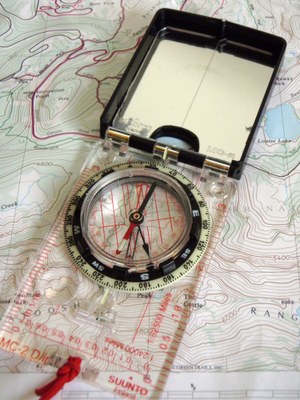
Navigation Course
Wilderness Navigation
The Wilderness Navigation Course provides the fundamentals of wilderness navigation to prepare you to competently and confidently enjoy hiking, climbing or getting off trail in the backcountry.
- Mon, Sep 13, 2021 - Sun, Sep 26, 2021
- Committee: Kitsap Navigation Committee
- Members: $90.00 Guests: $110.00
- Availability: FULL, 10 on waitlist (16 capacity)
- Cancellation & Refund Policy
NOTE: Only open to Kitsap Branch members and Kitsap/Olympic Peninsula residents until September 1, 2021. Course is open to all after September 1, 2021.
The Kitsap Mountaineers Wilderness Navigation course consists of two parts: an online classroom and a one-day field trip to Green Mountain. To successfully complete the course and earn the Basic Navigation badge, you must complete both parts.
This course is a graduation requirement for other Mountaineers courses including Basic Alpine Climbing, Alpine Scrambling, and Backcountry Snowshoeing. The Navigation badge is valid for 3 years.
SIGN UP PROCEDURE:
- Register for this Wilderness Navigation Course and pay the course fee (registration link located in green box at right).
- Sign up for the eLearning workshop ("Online Classroom").
- Sign up for the Field Trip.
- Purchase the required book and map (listed in "Required Reading" below) and acquire a compass that meets the "Mountaineers Approved" requirements (as described in "Required Equipment" tab, also below).
e-Learning Workshop:
On the start date for the online workshop (see "Course Requirements" below), you will receive an email with instructions for logging into Coassemble, the Mountaineers' online learning management system. You will then have two weeks to complete the eLearning modules. The online workshop is self-paced and is expected to take 10-15 hours to complete, not including reading time. As you work through the modules, you will use your compass and Baring quadrangle map to solve a series of navigation story problems, and you will be directed to read specific chapters from the required book as you go.
Field Trip:
The one-day field trip will provide you with the opportunity to apply your navigation skills in an outdoor setting. We will meet at the Gold Creek Trailhead and review proper compass use, verify declination settings, and take a series of bearings. We will then move on to leap frog and solo navigation exercises. Expect 4-5 miles round trip; ~1200 ft. elevation gain. You'll be spending several hours off trail in the woods, so dress for the weather and remember to bring your Ten Essentials. Your Mountaineers-approved compass is required for this field trip. You will also need a Washington State Discover Pass to park at the trailhead.
Badges you will earn:
This course has no scheduled activities.
Besides the 10 essentials for the field trip, this course requires the following:
- Book. “Wilderness Navigation,” 3rd edition, by Burns and Burns (Note: the book and maps can be purchase directly from Mountaineers Books, and Mountaineers members receive a 20% discount.)
- Map. The Baring quadrangle will be used for the eLearning workshop.
- Computer. Needed for the online instruction and workshop. A phone is not useful for the online portions.
- Compass. You’ll need to have an appropriate compass before beginning the online instruction. This blog entry has useful advice. See below for more details.
Your compass MUST have the following features:
- Adjustable declination. Some compasses are sold with “declination scale,” which means the declination is NOT adjustable.
- A transparent, rectangular base plate 3-4 inches in length. You’ll need the transparency and the straight edges for plotting and triangulating on the map. Avoid models with small, oval, or tinted baseplates.
- Degrees in 2-degree (or 1-degree) increments and marked from 0 to 360°.You’ll need the accuracy of the 2‑degree increments. Avoid compasses called “quadrant,” that are marked 0-90° four times around the bezel.
- Meridian lines. These lines are marked inside the rotating dial and are parallel with the north-south line.
These features are also strongly recommended:
- Sighting mirror. This offers better precision and can also be used for signaling.
- Inclinometer. Also called a clinometer, this allows you to measure slope.
- Romer scale. While not essential, this will make your map work easier. A 1:24,000 metric Romer is ideal for working with the UTM scale on USGS maps.
If you're not sure where to start, the Suunto MC-2 NH USGS is one example of a compass that includes these features. The table on p. 36 of the required Burns & Burns book lists a number of similar models from various brands. Because manufacturers change their compasses periodically, double-check the feature set before making any purchases, and reach out to the course leaders if you have questions.
| Name/Description |
|---|
| USGS Baring Map.pdf |
| USGS Wildcat Lake.pdf |
| Green Mountain DNR Map.pdf |
| USGS_Topo_Map_Symbols.pdf |
| ISU UTM Paper An additional explanation of the UTM grid system. |
| USFS Map Scales Fact Sheet - FS105-02 Paper describing the various USGS map scales. |
| Kitsap Branch Wilderness Navigation Course Outline Topic outline of the course that covers eLearning and classroom versions of the course. Updated January 2018 to include electronic navigation planning using CALTOPO. |
| USGS_UTM.pdf |


 Basic Navigation Course
Basic Navigation Course